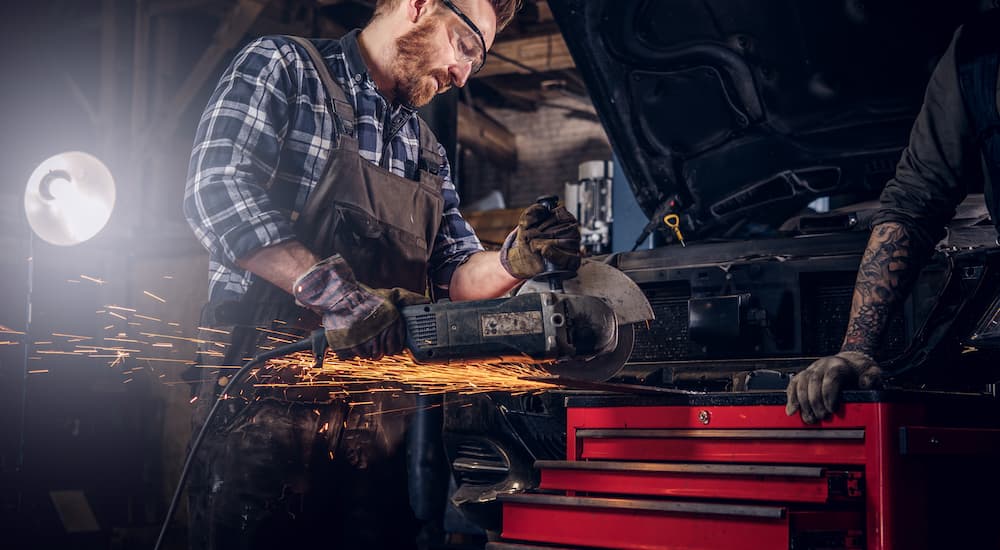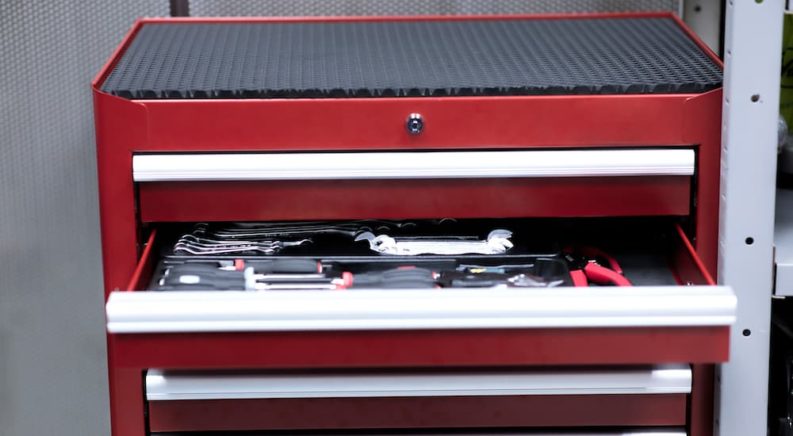The time has come. You’ve performed a couple of oil changes, replaced some light bulbs, and maybe even changed your brakes. You’re feeling pretty good about this DIY stuff, but the small collection of basic hand tools you’ve pieced together just won’t cut it for what you have planned. It’s time to drop some change and upgrade your arsenal with some serious firepower. Of course, you aren’t quite ready to invest thousands in a full professional-grade setup. So, with $1,000 to spend, what should you prioritize to maximize the bang for your buck and cover all your bases?
Tool Chest – $300
One of the first investments you will want to make isn’t a tool at all––it’s a tool chest. As you start building your tool collection, you will quickly realize that you need a place to store everything and keep it all organized. While spending several hundred dollars on a decent-sized tool chest may seem excessive and a waste of money at this point, trust us when we say that you’ll appreciate this investment down the road. Tools have a way of multiplying over time, and you are definitely going to want a good place to keep them all.
You might be tempted to go cheap here, but that’s not going to save you money in the long run. It’s best to bite the bullet and get a roomy, well-built tool chest now so you don’t find yourself running out of room and needing to upgrade in a couple of months. However, that doesn’t mean you need to spend four figures on a tool chest. With a little searching, you should be able to turn up some good options for around $300, especially if you look for sales.
Cordless Impact Wrench – $200
Once you’ve got your tool chest, the first big boy tool to invest in is an impact wrench. You don’t need many power tools for DIY automotive work, but a proper impact wrench will save you tons of time and sweat removing and replacing bolts and nuts. Don’t be afraid to spend a bit more for a high-quality item here, as this is something you will turn to for pretty much every job. When you buy a cordless tool, remember that the battery packs are just as important as the tool itself. Most manufacturers share a battery type for all their cordless tools from the same brand, so if you make a good choice here, you can use the batteries from your impact wrench for any other tools you buy in the future.
When selecting an impact wrench, you don’t need something with excessive amounts of torque unless you are working on heavy-duty trucks. A simple ⅜ inch impact will be fine for nearly everything on a passenger vehicle or light truck. Smaller tools can also be better since they can fit in tight places. Just make sure you get an impact wrench (the tool with the built-in drive) rather than an impact driver (the tool with the replaceable drives and bits). Most DIYers also prefer an impact with a friction ring rather than a pin detent as they are easier to remove sockets from.
Impact Rated Socket Set – $50
Once you have an impact wrench, you will need to get an impact-rated socket set for it. Using standard sockets with an impact isn’t a great idea. First, you have a much higher chance of breaking the sockets. Second, a non-impact-rated socket won’t transmit the full force of the impact wrench, robbing the tool of its full power. Impact-rated sockets are thicker and made of more resilient materials that allow them to stand up to hard use. They are usually a dull gray rather than a shiny silver but don’t rely on color alone to identify them.
A basic set of impact-rated sockets can be found for under $50 if you stick to Metric only. If you need SAE sockets or just want to cover all your bases, expect to double that. If you don’t have a set of deep wall sockets for your ratchet, one good trick to save money is to buy deep wall impact-rated sockets––the extra length of the socket likely won’t matter any place you can fit an impact wrench, and they can be used with your ratchet when you need the extra depth.
OBD2 Reader – $100
If you are doing serious automotive repairs, an OBD2 Reader is a must-have. There are a ton of options available these days, and a basic Bluetooth dongle that links to your phone can be had for around $20. However, we would recommend paying a bit more to get an OBD2 reader that is more secure and provides increased functionality. When shopping, be sure to research all the features that the tool offers. Not all OBD2 readers are created equal, and which one is best for you will depend on what you plan on using it for, what kinds of cars you work on, and whether you use Apple or Android if you want a reader that links to your phone. You should be able to find everything you need for under $100, but if you have specific requirements, don’t be afraid to spend a bit more to get them.

Angle Grinder – $100
After an impact driver, one of the most valuable power tools to have is an angle grinder––especially if you work on older cars. Sometimes, the best way to remove a rusted bolt is simply to cut it off, and an angle grinder will make short work of just about anything. An angle grinder is also a rather versatile tool as you can outfit it with a variety of different wheels designed to accomplish a number of tasks. A basic angle grinder is also fairly affordable, although if you want to splurge, we would recommend getting a cordless grinder that shares batteries with your impact wrench.
Creeper – $100
It only takes one oil change to realize why experienced mechanics use creepers to slide themselves under cars. What you may not realize is that a basic creeper is actually rather affordable and that you can get one for under $100. If you really want to be fancy, look for a creeper that you can also use as a seat for when you are working in the wheel wells, and try to find one that has room for a few tools on it. While this may not be a strictly necessary purchase, it is one that your body will thank you for.
Flex-Head Ratcheting Wrenches – $100
If an impact wrench is a massive upgrade over a ratchet, then flex-head ratcheting wrenches are an equivalent upgrade over your standard combination wrenches. A ratcheting box-end wrench will speed up any job where you need to break out your wrench set, and a flex-head wrench can fit just about anywhere. Combine the two features, and you have an incredibly versatile tool that you will turn to anytime you can’t use your impact wrench. A basic set may set you back nearly $100, but it’s an investment that will reduce frustration when you are working.

Pressure Washer – $50
Regularly cleaning your car is an important part of auto maintenance and makes crawling underneath it a lot more pleasant. Unfortunately, the garden hose isn’t the fastest, and it doesn’t always cut it when it comes to the wheels and undercarriage. The good news is that a basic electric pressure washer can be had for around $50. While you may be tempted to pay more and pick up a higher-powered unit, be aware that anything more powerful than 2000 PSI may damage the finish on your car. In this case, going cheap is perfectly sufficient.

